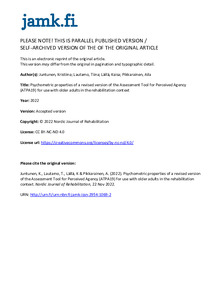Psychometric properties of a revised version of the Assessment Tool for Perceived Agency (ATPA19) for use with older adults in the rehabilitation context
Juntunen, Kristiina; Lautamo, Tiina; Lällä, Kaisa; Pikkarainen, Aila (2022)
Juntunen, Kristiina
Lautamo, Tiina
Lällä, Kaisa
Pikkarainen, Aila
Jyväskylän ammattikorkeakoulu
2022
Julkaisun pysyvä osoite on
https://urn.fi/URN:NBN:fi-fe2023030229233
https://urn.fi/URN:NBN:fi-fe2023030229233
Tiivistelmä
Background: It has been argued that an agency-based approach should be taken to person-centered gerontological rehabilitation. Such an approach requires agency-based assessment tools valid for use with older adults.
Objective: To evaluate the psychometric properties of the Assessment Tool for Perceived Agency (ATPA) adapted for older adults in gerontological rehabilitation in Finland.
Methods: Participants (n=97) were older adults aged 69 to 90 years. A many faceted Rasch (MFR) analysis was used to investigate the item and person response processes (goodness-of-fit statistics) and the separation reliability (separation index) of the ATPA.
Results: The ATPA19 items defined a unidimensional construct with moderate internal consistency and separation ability. More uncertainty than expected was found in within-person responses, mostly among females and participants aged 80 years or older.
Conclusion: The ATPA-19 is a promising tool to measure features of older adults’ perceived human agency. However, since perceived human agency is seen as a subjective and dynamic phenomenon that is constructed over the life course, research is needed on how human agency appears in different temporal periods, contexts, and populations.
Significance: Evaluating individuals’ perceived human agency with ATPA19 can help professionals strengthen the meaningful agency of older adults.
Objective: To evaluate the psychometric properties of the Assessment Tool for Perceived Agency (ATPA) adapted for older adults in gerontological rehabilitation in Finland.
Methods: Participants (n=97) were older adults aged 69 to 90 years. A many faceted Rasch (MFR) analysis was used to investigate the item and person response processes (goodness-of-fit statistics) and the separation reliability (separation index) of the ATPA.
Results: The ATPA19 items defined a unidimensional construct with moderate internal consistency and separation ability. More uncertainty than expected was found in within-person responses, mostly among females and participants aged 80 years or older.
Conclusion: The ATPA-19 is a promising tool to measure features of older adults’ perceived human agency. However, since perceived human agency is seen as a subjective and dynamic phenomenon that is constructed over the life course, research is needed on how human agency appears in different temporal periods, contexts, and populations.
Significance: Evaluating individuals’ perceived human agency with ATPA19 can help professionals strengthen the meaningful agency of older adults.
